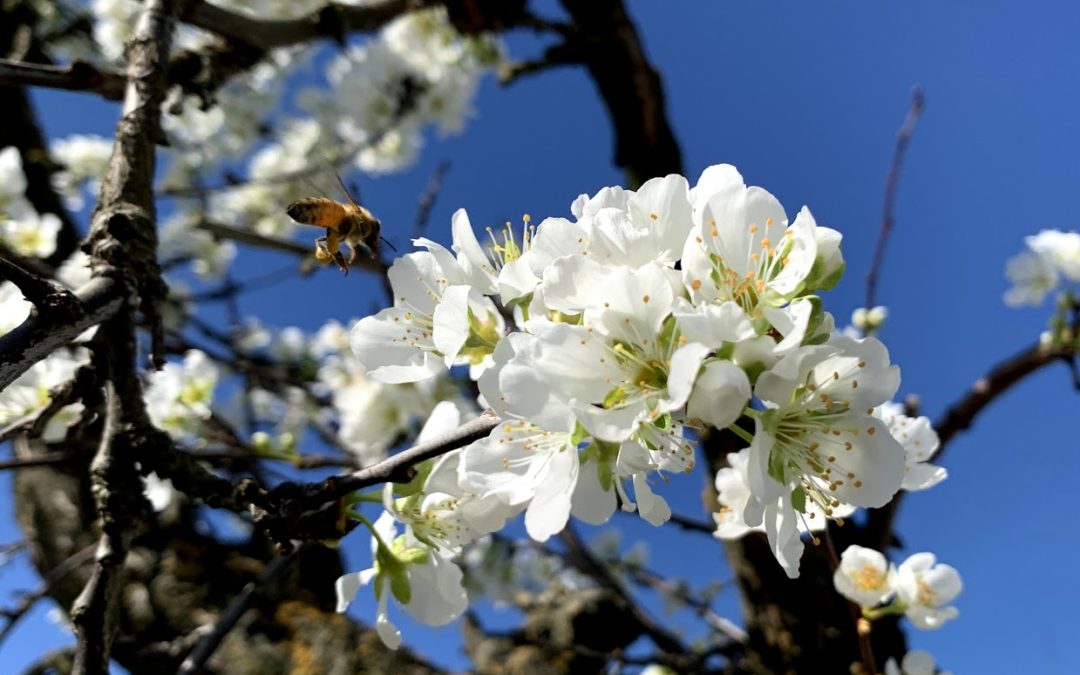Additional information:
- Overall rating for honeydew: 2/5
- Nectar: 2/3
- Pollen: 2/3
- Color: White/Beige
Blooming Plum tree in Contra Costa County California:
- February 2, 2025
- March 3, 2024
- February 25, 2023
- February 10, 2022
- February 3, 2021
I’m proud to help pollinate Brentwood’s plum trees with my local bees, which forage all year round in the Bay Area of San Francisco (California).
Bees play a pivotal role in the pollination of plum trees, as well as numerous other crops and wild plants. This process is essential for the production of fruit and the reproduction of many plant species. In the context of plum trees specifically, bees’ activities have a direct impact on the quantity and quality of the plum harvest. To understand why bees are so important for plum tree pollination, we need to delve into the mechanics of pollination, the role of bees in this process, and the broader implications of bee health on agricultural productivity.
Pollination is the act of transferring pollen from the male stamens of a flower to the female pistil. For many plants, including plum trees, this transfer is necessary for fertilization to occur, which ultimately leads to the production of fruit. Plum trees are angiosperms, which means they produce flowers that need to be pollinated to create fruit. Many plum varieties are self-incompatible, meaning they cannot pollinate themselves and require the pollen from flowers of a different plum tree variety for fertilization. Even self-pollinating varieties benefit from cross-pollination, as it tends to increase the yield and quality of the fruit.
Bees, especially honeybees and native bee species, are the most effective pollinators for plum trees. They are attracted to the flowers by nectar and pollen, which serve as food sources. As bees move from flower to flower collecting nectar, they inadvertently transfer pollen stuck to their bodies onto the pistil of other flowers, facilitating cross-pollination. This process is highly efficient with bees compared to other pollinators due to their body size, hairiness, and behavior patterns, which increase the likelihood of pollen transfer.
The importance of bees in plum tree pollination can be seen in the direct correlation between bee activity and the productivity of the plum orchards. Areas with higher bee populations tend to have more effectively pollinated plum trees, resulting in higher fruit set, larger fruits, and a more uniform ripening process. The efficiency of bees as pollinators also means that fewer flowers need to be visited for successful pollination, making the pollination process more energy-efficient for the plant.
The decline in bee populations due to pesticides, habitat loss, and disease presents a significant threat to the pollination of plum trees and, by extension, global agriculture. The reduction in bee numbers can lead to decreased pollination rates, negatively affecting fruit yield and quality. This underscores the importance of sustainable agricultural practices and conservation efforts aimed at protecting and supporting bee populations.
In conclusion, bees are indispensable to the pollination of plum trees. Their activities not only ensure the production of fruit but also contribute to the genetic diversity and health of plum populations through cross-pollination. The decline in bee populations highlights the fragile interdependence between pollinators and the plants they service. Protecting and promoting healthy bee populations is not just about preserving a single species but about maintaining the biodiversity and productivity of ecosystems that humans rely on for food. As such, efforts to understand and mitigate the challenges facing bee populations are essential for the continued success of agriculture, including the cultivation of plums and many other crops.

